air condition FORD E SERIES 2015 4.G Owners Manual
[x] Cancel search | Manufacturer: FORD, Model Year: 2015, Model line: E SERIES, Model: FORD E SERIES 2015 4.GPages: 360, PDF Size: 3.28 MB
Page 3 of 360

Lighting 60
Lighting control.......................................60
Instrument lighting dimmer...............................61
Daytime running lamps..................................61
Turn signal control.....................................62
Interior lamps........................................62
Windows and Mirrors 63
Power windows.......................................63
Exteriormirrors.......................................64
Interiormirrors .......................................67
Sunvisors ...........................................67
Instrument Cluster 68
Gauges.............................................68
Warning lamps and indicators.............................70
Audible warnings and indicators...........................73
Information Displays 74
Controls.............................................74
Information messages...................................79
Climate Control 82
Manual heating and air conditioning........................82
Seats 86
Sitting in the correct position.............................86
Head restraints........................................87
Manual seats.........................................87
Power seats..........................................89
Auxiliary Power Points 90
Starting and Stopping the Engine 93
Ignition switch........................................94
Engine block heater....................................97
2Table of Contents
2015 Econoline(eco)
Owners Guide gf, 1st Printing, June 2014
USA(fus)
Page 12 of 360
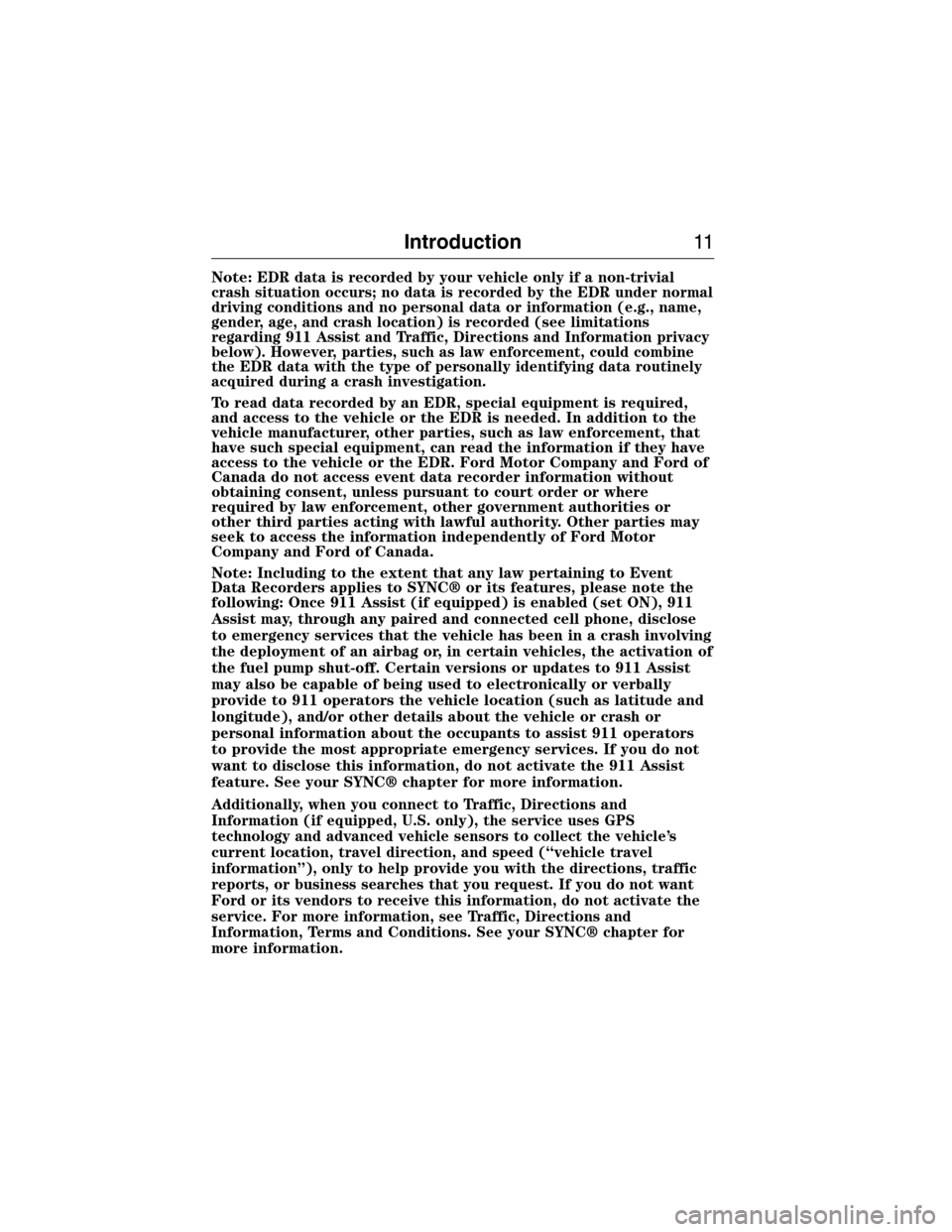
Note:EDR data is recorded by your vehicle only if a non-trivial
crash situation occurs; no data is recorded by the EDR under normal
driving conditions and no personal data or information (e.g., name,
gender, age, and crash location) is recorded (see limitations
regarding 911 Assist and Traffic, Directions and Information privacy
below). However, parties, such as law enforcement, could combine
the EDR data with the type of personally identifying data routinely
acquired during a crash investigation.
To read data recorded by an EDR, special equipment is required,
and access to the vehicle or the EDR is needed. In addition to the
vehicle manufacturer, other parties, such as law enforcement, that
have such special equipment, can read the information if they have
access to the vehicle or the EDR. Ford Motor Company and Ford of
Canada do not access event data recorder information without
obtaining consent, unless pursuant to court order or where
required by law enforcement, other government authorities or
other third parties acting with lawful authority. Other parties may
seek to access the information independently of Ford Motor
Company and Ford of Canada.
Note:Including to the extent that any law pertaining to Event
Data Recorders applies to SYNC® or its features, please note the
following: Once 911 Assist (if equipped) is enabled (set ON), 911
Assist may, through any paired and connected cell phone, disclose
to emergency services that the vehicle has been in a crash involving
the deployment of an airbag or, in certain vehicles, the activation of
the fuel pump shut-off. Certain versions or updates to 911 Assist
may also be capable of being used to electronically or verbally
provide to 911 operators the vehicle location (such as latitude and
longitude), and/or other details about the vehicle or crash or
personal information about the occupants to assist 911 operators
to provide the most appropriate emergency services. If you do not
want to disclose this information, do not activate the 911 Assist
feature. See your SYNC® chapter for more information.
Additionally, when you connect to Traffic, Directions and
Information (if equipped, U.S. only), the service uses GPS
technology and advanced vehicle sensors to collect the vehicle’s
current location, travel direction, and speed (“vehicle travel
information”), only to help provide you with the directions, traffic
reports, or business searches that you request. If you do not want
Ford or its vendors to receive this information, do not activate the
service. For more information, see Traffic, Directions and
Information, Terms and Conditions. See your SYNC® chapter for
more information.
Introduction11
2015 Econoline(eco)
Owners Guide gf, 1st Printing, June 2014
USA(fus)
Page 14 of 360

Collision Repairs
We hope that you never experience a collision, but accidents do happen.
Genuine Ford replacement collision parts meet our stringent requirements
for fit, finish, structural integrity, corrosion protection and dent resistance.
During vehicle development, we validate that these parts deliver the
intended level of protection as a whole system. A great way to know for
sure you are getting this level of protection is to use genuine Ford
replacement collision parts.
Warranty on Replacement Parts
Genuine Ford and Motorcraft replacement parts are the only replacement
parts that benefit from a Ford Warranty. Damage caused to your vehicle as
a result of the failure of non-Ford parts may not be covered by the Ford
Warranty. For additional information, see the terms and conditions of the
Ford Warranty.
SPECIAL NOTICES
New Vehicle Limited Warranty
For a detailed description of what is covered and what is not covered by
your vehicle’s New Vehicle Limited Warranty, see the warranty
information that is provided to you along with your owner’s manual.
Special Instructions
For your added safety, your vehicle is fitted with sophisticated electronic
controls.
WARNING:Please read theSupplementary Restraints System
chapter. Failure to follow the specific warnings and instructions
could result in personal injury.
WARNING:Front seat mounted rear-facing child or infant seats
shouldNEVERbe placed in front of an active passenger airbag.
Introduction13
2015 Econoline(eco)
Owners Guide gf, 1st Printing, June 2014
USA(fus)
Page 45 of 360
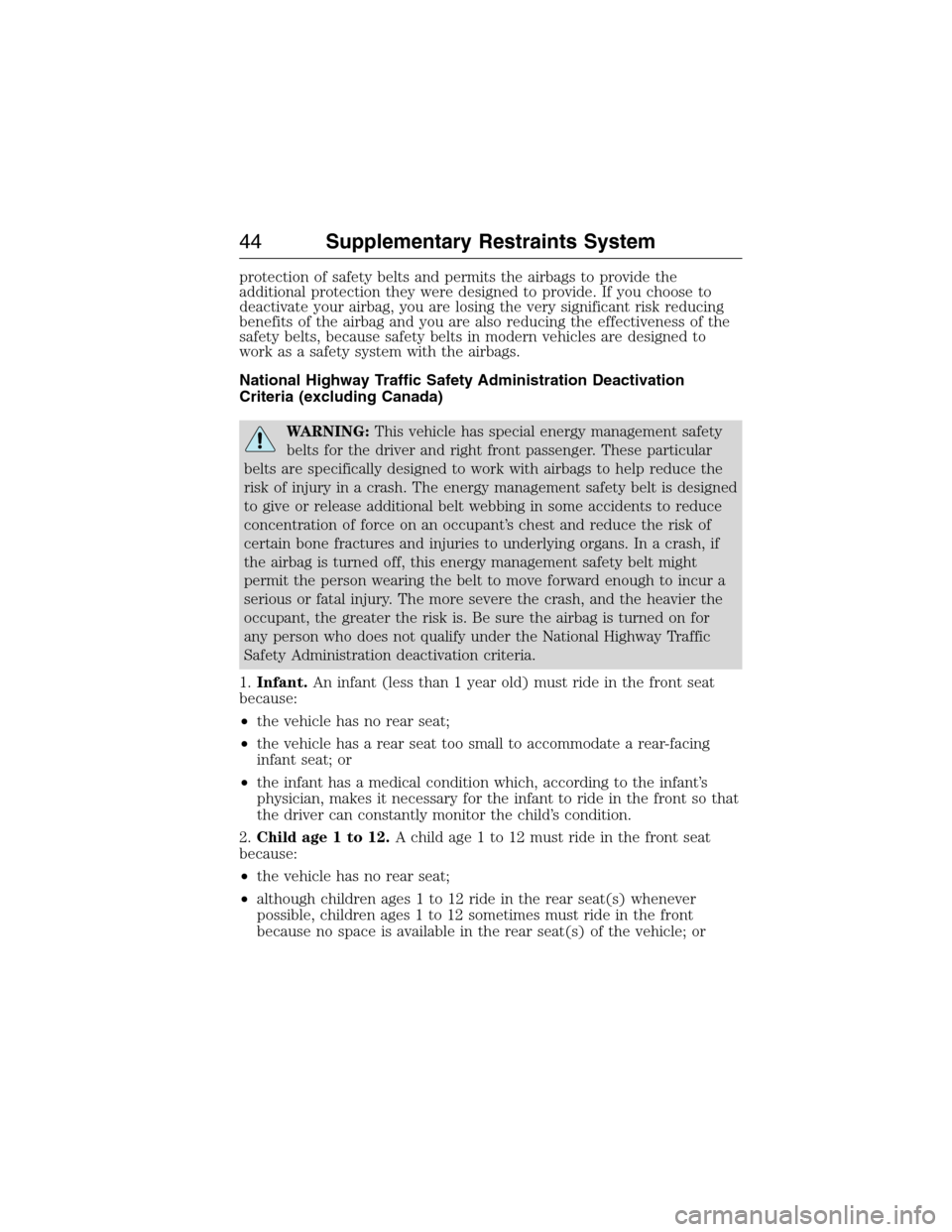
protection of safety belts and permits the airbags to provide the
additional protection they were designed to provide. If you choose to
deactivate your airbag, you are losing the very significant risk reducing
benefits of the airbag and you are also reducing the effectiveness of the
safety belts, because safety belts in modern vehicles are designed to
work as a safety system with the airbags.
National Highway Traffic Safety Administration Deactivation
Criteria (excluding Canada)
WARNING:This vehicle has special energy management safety
belts for the driver and right front passenger. These particular
belts are specifically designed to work with airbags to help reduce the
risk of injury in a crash. The energy management safety belt is designed
to give or release additional belt webbing in some accidents to reduce
concentration of force on an occupant’s chest and reduce the risk of
certain bone fractures and injuries to underlying organs. In a crash, if
the airbag is turned off, this energy management safety belt might
permit the person wearing the belt to move forward enough to incur a
serious or fatal injury. The more severe the crash, and the heavier the
occupant, the greater the risk is. Be sure the airbag is turned on for
any person who does not qualify under the National Highway Traffic
Safety Administration deactivation criteria.
1.Infant.An infant (less than 1 year old) must ride in the front seat
because:
•the vehicle has no rear seat;
•the vehicle has a rear seat too small to accommodate a rear-facing
infant seat; or
•the infant has a medical condition which, according to the infant’s
physician, makes it necessary for the infant to ride in the front so that
the driver can constantly monitor the child’s condition.
2.Child age 1 to 12.A child age 1 to 12 must ride in the front seat
because:
•the vehicle has no rear seat;
•although children ages 1 to 12 ride in the rear seat(s) whenever
possible, children ages 1 to 12 sometimes must ride in the front
because no space is available in the rear seat(s) of the vehicle; or
44Supplementary Restraints System
2015 Econoline(eco)
Owners Guide gf, 1st Printing, June 2014
USA(fus)
Page 46 of 360

•the child has a medical condition which, according to the child’s
physician, makes it necessary for the child to ride in the front seat so
that the driver can constantly monitor the child’s condition.
3.Medical condition.A passenger has a medical condition which,
according to his or her physician:
•causes the passenger airbag to pose a special risk for the passenger;
and
•makes the potential harm from the passenger airbag in a crash greater
than the potential harm from turning off the airbag and allowing the
passenger, even if belted, to hit the dashboard or windshield in a
crash.
Transport Canada Deactivation Criteria (Canada Only)
WARNING:This vehicle has special energy management safety
belts for the driver and right front passenger. These particular
belts are specifically designed to work with airbags to help reduce the
risk of injury in a crash. The energy management safety belt is designed
to give or release additional belt webbing in some accidents to reduce
concentration of force on an occupant’s chest and reduce the risk of
certain bone fractures and injuries to underlying organs. In a crash, if
the airbag is turned off, this energy management safety belt might
permit the person wearing the belt to move forward enough to incur a
serious or fatal injury. The more severe the crash, and the heavier the
occupant, the greater the risk is. Be sure the airbag is turned on for
any person who does not qualify under the National Highway Traffic
Safety Administration deactivation criteria.
1.Infant:An infant (less than 1 year old) must ride in the front seat
because:
•my vehicle has no rear seat;
•the rear seat in my vehicle cannot accommodate a rear-facing infant
seat; or
•the infant has a medical condition which, according to the infant’s
physician, makes it necessary for the infant to ride in the front seat so
that the driver can monitor the infant’s condition.
Supplementary Restraints System45
2015 Econoline(eco)
Owners Guide gf, 1st Printing, June 2014
USA(fus)
Page 47 of 360

2.Child age 12 or under:A child age 12 or under must ride in the
front seat because:
•my vehicle has no rear seat;
•although children age 12 and under ride in the rear seat whenever
possible, children age 12 and under have no option but to sometimes
ride in the front seat because rear seat space is insufficient; or
•the child has a medical condition that, according to the child’s
physician, makes it necessary for the child to ride in the front seat so
that the driver can monitor the child’s condition.
3.Medical condition:A passenger has a medical condition that,
according to his or her physician:
•poses a special risk for the passenger if the airbag deploys; and
•makes the potential harm from the passenger airbag deployment
greater than the potential harm from turning off the airbag and
experiencing a crash without the protection offered by the airbag
CRASH SENSORS AND AIRBAG INDICATOR
WARNING:Modifying or adding equipment to the front end of
your vehicle (including frame, bumper, front end body structure
and tow hooks) may affect the performance of the airbag system,
increasing the risk of injury. Do not modify the front end of your
vehicle.
Your vehicle has a collection of crash and occupant sensors which
provide information to the restraints control module. The restraints
control module deploys (activates) the front safety belt pretensioners,
driver airbag and passenger airbag. Based on the type of accident, the
restraints control module will deploy the appropriate safety devices.
The restraints control module also monitors the readiness of the above
safety devices plus the crash sensors. The readiness of the safety system
is indicated by a warning indicator light in the instrument cluster or by a
backup tone if the warning light is not working. See theInstrument
Clusterchapter. Routine maintenance of the airbag is not required.
46Supplementary Restraints System
2015 Econoline(eco)
Owners Guide gf, 1st Printing, June 2014
USA(fus)
Page 48 of 360
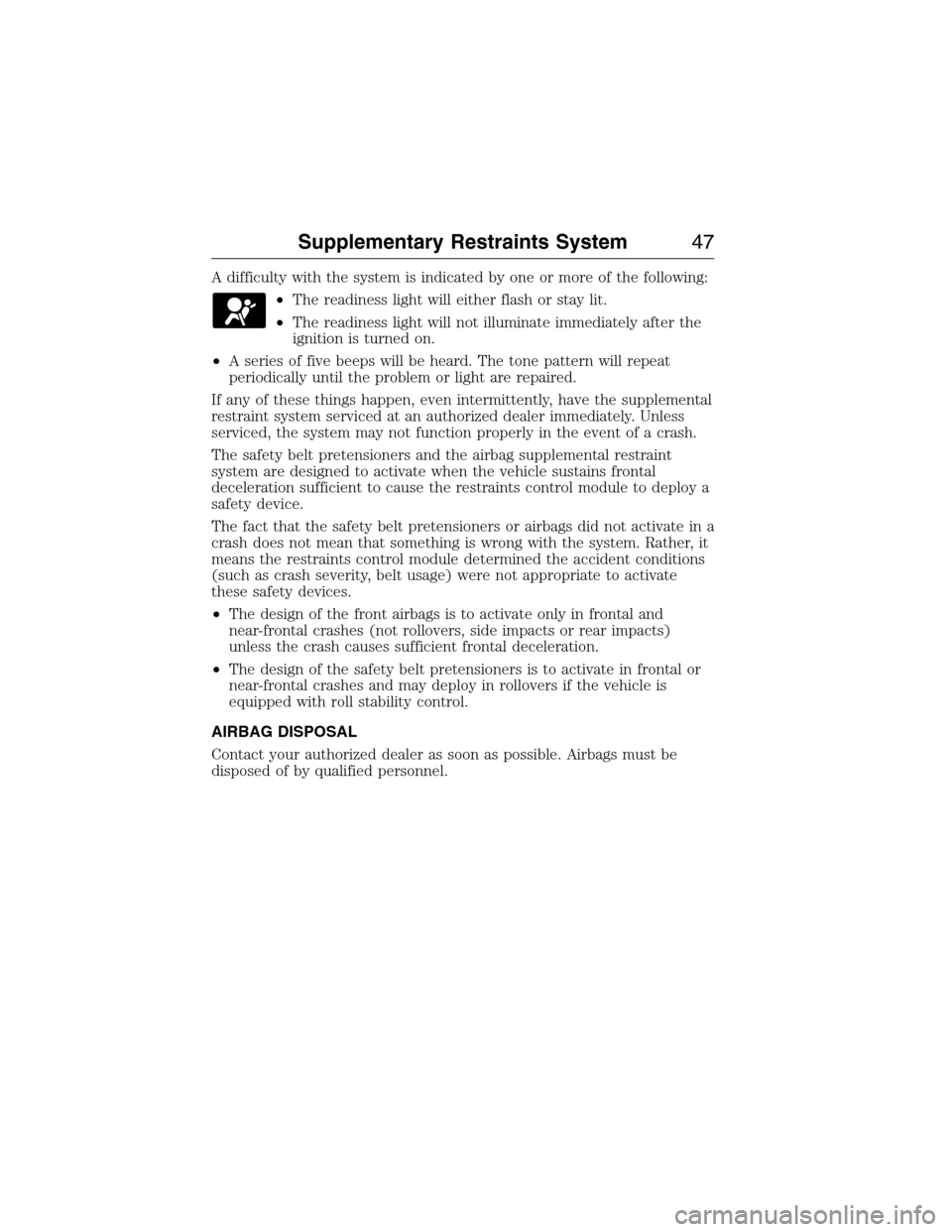
A difficulty with the system is indicated by one or more of the following:
•The readiness light will either flash or stay lit.
•The readiness light will not illuminate immediately after the
ignition is turned on.
•A series of five beeps will be heard. The tone pattern will repeat
periodically until the problem or light are repaired.
If any of these things happen, even intermittently, have the supplemental
restraint system serviced at an authorized dealer immediately. Unless
serviced, the system may not function properly in the event of a crash.
The safety belt pretensioners and the airbag supplemental restraint
system are designed to activate when the vehicle sustains frontal
deceleration sufficient to cause the restraints control module to deploy a
safety device.
The fact that the safety belt pretensioners or airbags did not activate in a
crash does not mean that something is wrong with the system. Rather, it
means the restraints control module determined the accident conditions
(such as crash severity, belt usage) were not appropriate to activate
these safety devices.
•The design of the front airbags is to activate only in frontal and
near-frontal crashes (not rollovers, side impacts or rear impacts)
unless the crash causes sufficient frontal deceleration.
•The design of the safety belt pretensioners is to activate in frontal or
near-frontal crashes and may deploy in rollovers if the vehicle is
equipped with roll stability control.
AIRBAG DISPOSAL
Contact your authorized dealer as soon as possible. Airbags must be
disposed of by qualified personnel.
Supplementary Restraints System47
2015 Econoline(eco)
Owners Guide gf, 1st Printing, June 2014
USA(fus)
Page 71 of 360
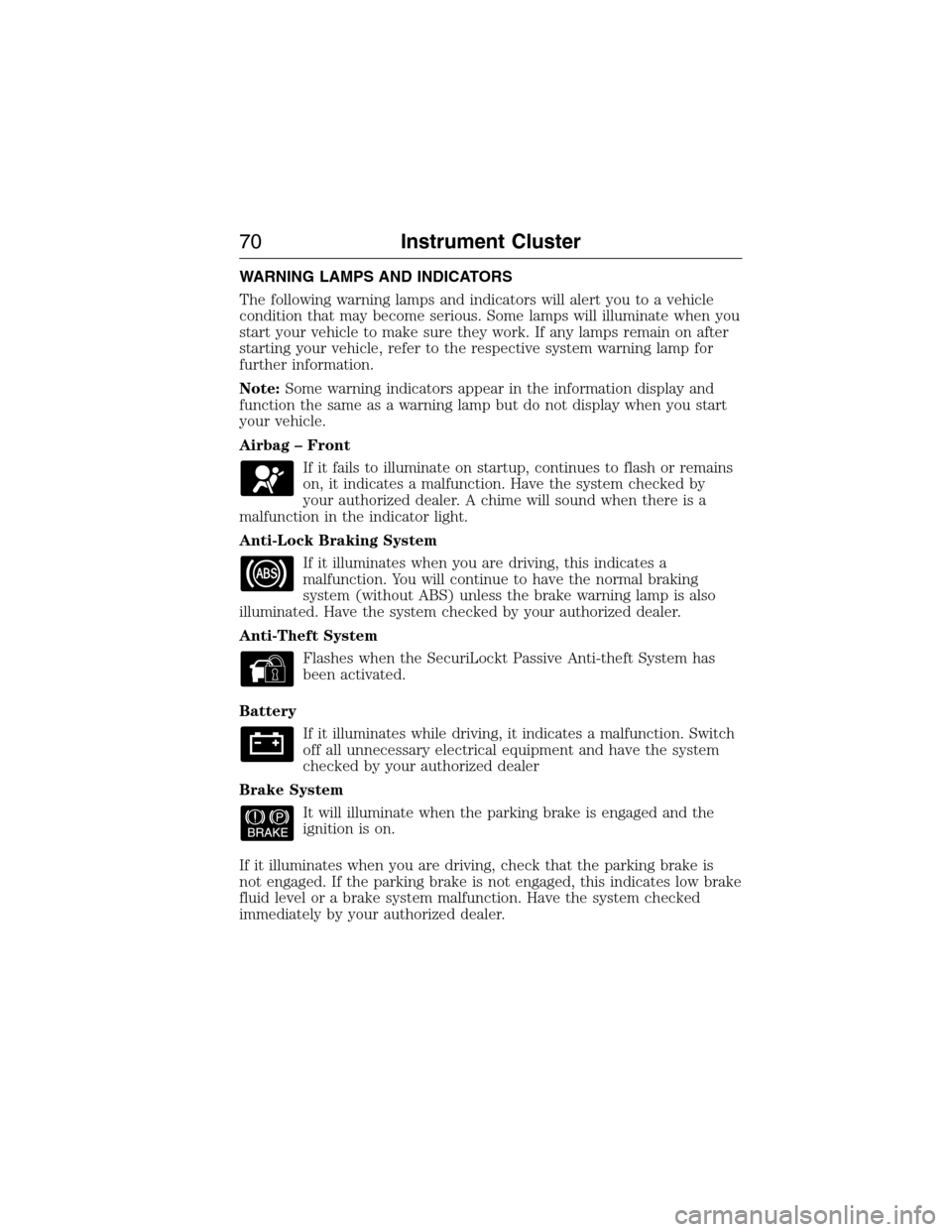
WARNING LAMPS AND INDICATORS
The following warning lamps and indicators will alert you to a vehicle
condition that may become serious. Some lamps will illuminate when you
start your vehicle to make sure they work. If any lamps remain on after
starting your vehicle, refer to the respective system warning lamp for
further information.
Note:Some warning indicators appear in the information display and
function the same as a warning lamp but do not display when you start
your vehicle.
Airbag – Front
If it fails to illuminate on startup, continues to flash or remains
on, it indicates a malfunction. Have the system checked by
your authorized dealer. A chime will sound when there is a
malfunction in the indicator light.
Anti-Lock Braking System
If it illuminates when you are driving, this indicates a
malfunction. You will continue to have the normal braking
system (without ABS) unless the brake warning lamp is also
illuminated. Have the system checked by your authorized dealer.
Anti-Theft System
Flashes when the SecuriLockt Passive Anti-theft System has
been activated.
Battery
If it illuminates while driving, it indicates a malfunction. Switch
off all unnecessary electrical equipment and have the system
checked by your authorized dealer
Brake System
It will illuminate when the parking brake is engaged and the
ignition is on.
If it illuminates when you are driving, check that the parking brake is
not engaged. If the parking brake is not engaged, this indicates low brake
fluid level or a brake system malfunction. Have the system checked
immediately by your authorized dealer.
70Instrument Cluster
2015 Econoline(eco)
Owners Guide gf, 1st Printing, June 2014
USA(fus)
Page 84 of 360
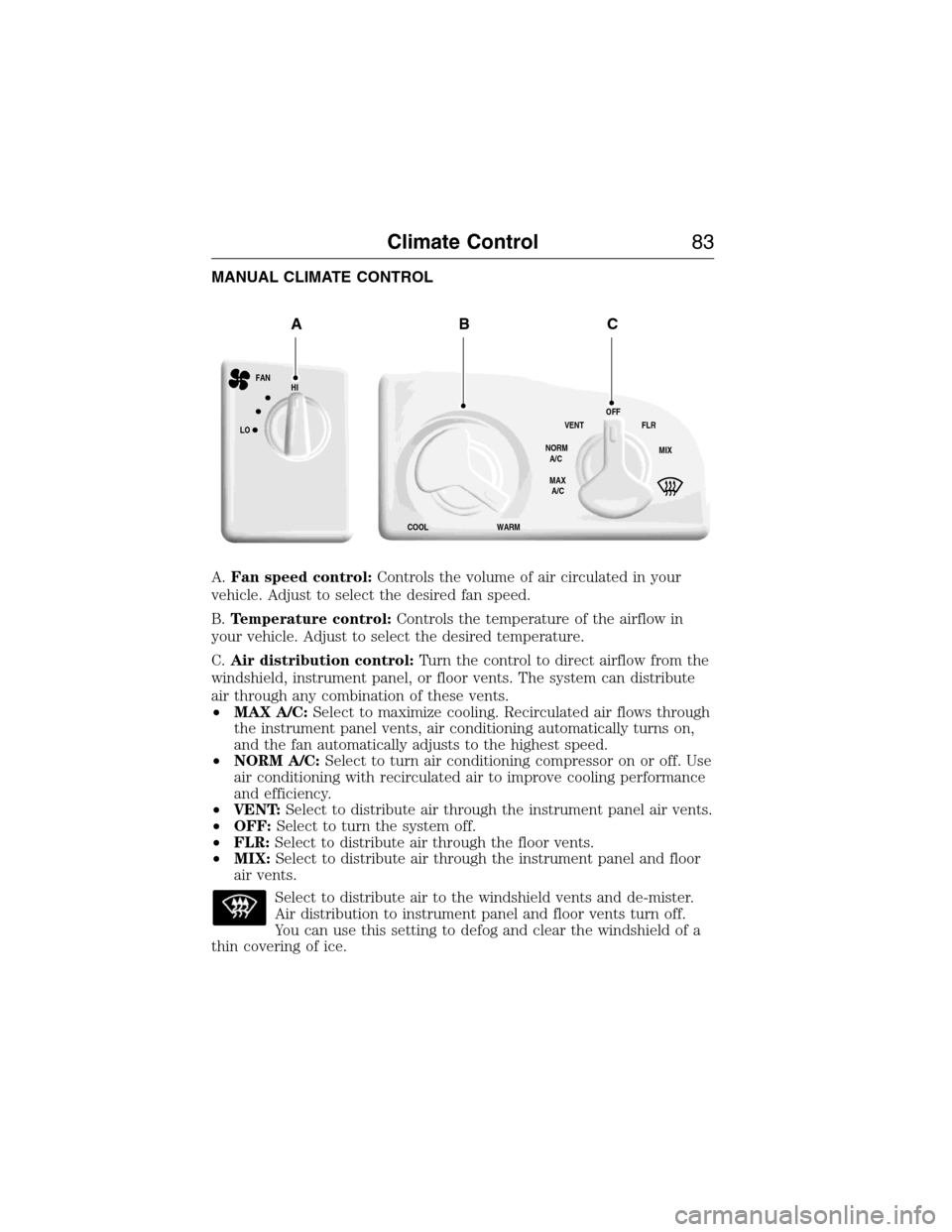
MANUAL CLIMATE CONTROL
A.Fan speed control:Controls the volume of air circulated in your
vehicle. Adjust to select the desired fan speed.
B.Temperature control:Controls the temperature of the airflow in
your vehicle. Adjust to select the desired temperature.
C.Air distribution control:Turn the control to direct airflow from the
windshield, instrument panel, or floor vents. The system can distribute
air through any combination of these vents.
•MAX A/C:Select to maximize cooling. Recirculated air flows through
the instrument panel vents, air conditioning automatically turns on,
and the fan automatically adjusts to the highest speed.
•NORM A/C:Select to turn air conditioning compressor on or off. Use
air conditioning with recirculated air to improve cooling performance
and efficiency.
•VENT:Select to distribute air through the instrument panel air vents.
•OFF:Select to turn the system off.
•FLR:Select to distribute air through the floor vents.
•MIX:Select to distribute air through the instrument panel and floor
air vents.
Select to distribute air to the windshield vents and de-mister.
Air distribution to instrument panel and floor vents turn off.
You can use this setting to defog and clear the windshield of a
thin covering of ice.
HI
LO
COOL WARMVENT
NORM
A/C
MAX
A/COFF
MIX FLR FAN
ABC
Climate Control83
2015 Econoline(eco)
Owners Guide gf, 1st Printing, June 2014
USA(fus)
Page 97 of 360

Cold Weather Starting (Flexible Fuel Vehicles Only)
Note:Do not crank the engine for more than 10 seconds at a time as
starter damage may occur. If the engine fails to start, turn the key to off
and wait 30 seconds before trying again.
Note:Do not use starting fluid such as ether in the air intake system.
Such fluid could cause immediate explosive damage to the engine and
possible personal injury.
Note:You may experience a decrease in peak performance when the
engine is cold when operating on E85 ethanol.
The starting characteristics of all grades of E85 ethanol make it
unsuitable for use when ambient temperatures fall below 0°F (-18°C).
Consult your fuel distributor for the availability of winter grade ethanol.
As the outside temperature approaches freezing, ethanol fuel distributors
should supply winter grade ethanol (same as with unleaded gasoline).
If summer grade ethanol is used in cold weather conditions, 0°F to 32°F
(-18°C to 0°C), you may experience increased cranking times, rough idle
or hesitation until the engine has warmed up.
If you should experience cold weather starting problems on E85 ethanol,
and neither an alternative brand of E85 ethanol nor an engine block
heater is available, adding unleaded gasoline to your tank improves cold
starting performance. Your vehicle is designed to operate on E85 ethanol
alone, unleaded gasoline alone, or any mixture of the two.
SeeChoosing the right fuelin theFuels and Refuelingchapter for
more information on ethanol.
Guarding Against Exhaust Fumes
WARNING:If you smell exhaust fumes inside your vehicle, have
this checked immediately. Do not drive your vehicle if you smell
exhaust fumes. Carbon monoxide is present in exhaust fumes. Take
precautions to avoid its dangerous effects.
Important Ventilating Information
If you stop your vehicle and leave the engine idling for long periods,
we recommend that you do one of the following:
•Open the windows at least 1 inch (2.5 centimeters).
•Set your climate control to outside air.
96Starting and Stopping the Engine
2015 Econoline(eco)
Owners Guide gf, 1st Printing, June 2014
USA(fus)